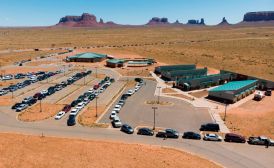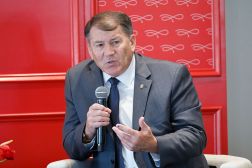TTS Director Ann Lewis to step down from GSA

Ann Lewis, the director of Technology Transformation Services and deputy commissioner of the Federal Acquisition Service, is leaving the General Services Administration after almost two years.
Lewis will leave the agency on Nov. 22, according to a Tuesday press release. Mukunda Penugonde, who currently serves as deputy director of TTS, will step in as acting director and deputy commissioner.
Lewis was tapped by the Biden administration in December 2022 to serve at GSA after a lengthy career in the private sector, including as chief technology officer at Next Street, a business advisory firm, and as CTO at the public policy advocacy group MoveOn.
In a previous interview with FedScoop, Lewis said that after 15 years in the private sector, she was “really hungry for work that I felt like was in line with my values.” With TTS, Lewis has led efforts to use artificial intelligence in the federal government, while supporting digital services initiatives that leverage large pools of data.
“It’s clear that the work we do is valuable, but if it’s so valuable, I want to point that energy and that opportunity and that value in the direction of something I really care about,” Lewis said. “I really, really care about things like government benefits and the social safety net of the United States.”
She continued: “I think it’s a really exciting idea, that government can make good on its promise to the public of delivering all these benefits and services. There’s a lot of challenges with the way that works right now, but instead of experiencing broken government services and being frustrated about it, I wanted to really be in there and helping fix things.”
AI talent and retention
During her time at GSA, Lewis prioritized workforce development and recruitment, telling FedScoop that college students or aspiring technologists should “consider government as a career path.” She pointed to the scale of government projects,noting that every project is going to touch millions, if not billions, of people.
She was a part of efforts to bring on AI talent through programs like the U.S. Digital Corps and the Presidential Innovation Fellows, which recently welcomed AI-specific members.
Lewis said the GSA anticipated that AI talent was going to be in “high demand,” but also found plenty of applicants that “actually want to work for the government.”
She pointed to cohorts’ work across agencies as an example of how the federal government can build AI capacity. Upskilling and training, she said, was another way to increase AI talent in the federal government.
“We can hire people with data science skills or direct experience in artificial intelligence or in AI-enabling fields, but a lot of software engineers and data scientists already in government are training up on AI right now because there’s so much to learn, and there are new breakthroughs every week,” Lewis said.
With AI-driven code generation systems as well as AI-generative images and texts, the technology can enable people to get more into problem spaces that they might have been intimated by previously, she added.
“I think it’s helpful to think about AI as the great enabler,” Lewis said. “You don’t have to be an expert to do tech work, although I know that there’s definitely a lot of barriers in the tech world based on tech culture that have, in the past, prevented people from feeling like they could ask questions or get their hands dirty or get into the details.”
Digital services and data
Under Lewis’ direction, the GSA last month announced that facial recognition technology would become generally available to allow for federal agencies to verify users at a higher assurance level.
She said in the September interview with FedScoop that TTS programs, including Login.gov, were trying to prioritize “accessibility, user research and language access.” Individual programs would look at the demographics and the breadth of individuals who come to websites, including Login.gov, and identify a need based on the data, she said.
“It’s thinking holistically about, what are the needs of the people who are coming to this website and how can we accommodate those needs and how can we test our assumptions there, so we know for sure that we’re meeting user needs,” Lewis said.
Harnessing the power of data, when it is stored in many places, is the key to successful AI implementation and tools because those tools are only as powerful as the data you put in them, according to Lewis. “There are so many different pieces of the puzzle here with data,” she said.
GSA tries to drive broad adoption of tools, Lewis said, such as the Digital Analytics Program, to look across the agencies and gain data insights. Lewis compared it to an enterprise data challenge throughout the government to “figure out.”
“I think that government is all over the place in terms of maturity for that,” Lewis said. “Within GSA, there are still mainframes that critical acquisitions or building data lives in, so you need to think about pragmatic ways of, if you do try and do a big data migration, you’ll spend years waiting for it to be done and maybe not have business value for a while.”
She continued: “But there are ways that you can break up those really big modernization tasks into small pieces.”
Lewis said that AI is changing the way that “so many different categories of work are happening,” and that “not one category is better or more impactful than the rest.” The building blocks that GSA is using to build all of its systems and tools, she said, are “fundamentally changing.”






